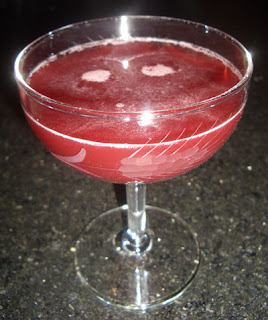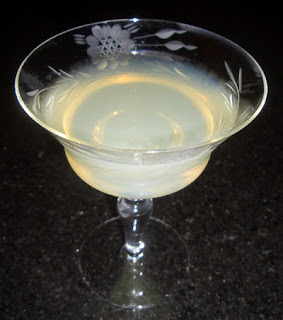To finish up the trilogy of my year end wrap ups, I figured that I should revisit all of the recipes we tried at our home bar this year. Our cocktail book library expanded this year with older books like
Bottoms Up and
The How and When and new releases like
Left Coast Libations and
Absinthe Cocktails, and with this growth, the wealth of resources I can pull recipes from has increased. While most of the drinks are pre-existing recipes, a few were created for Thursday Drink Nights and other events and a couple of these even found publication in places like the
Mutineer Magazine, on menus, or winning a cocktail contest. Just like my summary of the drinks I had out in 2010, I will go month by month and recap the top libations I experienced in my kitchen.
January: The best drink in January did not come by way of new cocktail book or old, but by way of Twitter! The Anvil in Houston tweeted the recipe for
The Eulogy, a Last Word variation using Batavia Arrack, Yellow Chartreuse, falernum, and lime. Interestingly, Chuck Taggart of the
Gumbo Pages made it down to Houston and reported back that the Anvil makes the drink with Strega instead of Yellow Chartreuse, so either liqueur will work. As a runner up, another WTF recipe from the
Rogue Beta Cocktails book proves to be a tasty potation (despite our doubts, no recipe from that book has failed us). The
Broken Shoe Shiner created at the Violet Hour impressed us greatly despite the ingredients list giving us pause.
February: February's best drink comes not from Twitter but from a Peruvian cocktail book that our friend Héctor gave to us. The
Zambito paired up coffee-infused Pisco with lime to make a surprisingly rich and complex Sour drink. The runner up recipe, the
Esmeralda, came via text message after speaking to our St. Germain rep, Kate, who fetched the recipe from Ben Sandrof, the creator. With the St. Germain being balanced by lime and with the cachaça being complemented by a smoky Scotch rinse, this Daisy was a gem.
March: I narrowed March down to two drinks that I found equally as enjoyable. The
Madelaine Cocktail from the 1947
Trader Vic was another delightful Daisy with lemon and lime countering Drambuie liqueur. Perhaps it was the Treaty Oak aged white rum that helped to make this drink succeed. The other drink was also a rum one, the
Happy Daze from the
Café Royal Cocktail Book. Despite the silly name, the light complexity of flavors that Lillet and a touch of Swedish Punsch added to the rum made for an elegant drink.
April: This month's winner came from a copy of Green Street's cocktail book; the
Joe's Fashion was crafted by Misty Kalkofen for a James Beard event in 2007 and the combination of Punt e Mes and Chinese 5 Spice syrup really worked well with apple brandy. The runner up came from Stan Jones'
Complete Barguide; the
Port Antonio was a Tiki drink that, like the Zambito, reminded me how great coffee and lime flavors pair up.
May: We started Julep season off with a bang; the
Platonic Julep from
Pioneers of Mixing at Elite Bars: 1903-1933 had European stylings as it paired sherry with Yellow Chartreuse as the spirit. Another Julep we had in May should win the year's tastiest virgin cocktail (yes, Cocktail Virgin does have some virgin cocktails) which I presented for the Tom Waits Mixology Monday, namely the
Tea Julep from the 1920
What to Drink written by the Jerry Thomas of Temperance drinks, Bertha Stockbridge. The runner up for May was simple but elegant -- the
Perfect Lady from
Latin Quarter Souvenir Book Of Cocktails & How To Mix Them; the substitution of the Pink Lady's applejack and grenadine for a quality Crème de Pêche was delightful.
June: My picks for June stem from Ted Saucier's
Bottoms Up; Saucier's tome was the earliest recipe for the Last Word, and these two are variations of it. The
D.J. was created at the Detroit Athletic Club where the Last Word was born; the equal parts number varies from the Last Word by using sweet vermouth and grapefruit in place of Green Chartreuse and lime (oh, and a hazelnut garnish). The
Californie Place, however, was created in Cannes, France. While it is not equal parts, the recipe uses dry vermouth's crispness in place of the Last Word's lime to make a great aperitif cocktail.
July: July's winner should have been had a bar, but Eastern Standard lacked the seasonally obtained liqueur, Becherovka. Using our old bottle, we were able to make Bobby McCoy's winning
Elixir Alpestre recipe. As a runner up, the equal parts
One Way from
Café Royal Cocktail Book reminded me of the Perfect Lady with peach and lemon flavors with the addition of Swedish Punsch.
August: The Secret Sherry Society provided us with our top pick, Thomas Waugh's
Delores Park Swizzle. Sherry, tequila, citrus, ginger, and other spices made for a superb drink! A solid drink worth mentioning was created here in Boston decades ago; the
Parker House Punch from
Bottoms Up is not full of razzle-dazzle but succeeds with a strong, classic touch.
September: The
Emerson Cocktail from Jacques Straub's 1914 book
Drinks was a rather memorable find in September. A Martinez-like drink with the addition of lime is one that I ought to repeat with the Ransom Old Tom Gin we recently purchased. Also of note is that the Emerson appears on Todd Maul's menu at Clio. For a runner up, I went with another modified classic. The
Georgetown Club Cocktail from Charles H. Baker, Jr.'s
South American Companion: Up & Down the Andes with Jigger, Beaker, & Flask was like a Bacardi Dry supplemented by falernum or a Palmetto with the spiced syrup in place of bitters. I was reminded of this dry aperitif wine plus falernum combination when I had the
No. 65 at Hungry Mother a few weeks back.
October: The Secret Sherry Society helped to welcome in Autumn with Erick Castro's
French Toast Flip! Maple syrup, malt, smoke, and cinnamon added to the egg to give a remembrance of breakfasts past. As a runner up, Espolón Tequila provided me H. Joseph Ehrmann's
Ashes to Ashes as a chocolate, sherry, and cinnamon tribute to Day of the Dead.
November: Andrea chimed in on November and considered Kelley Swenson's
Celeriac from
Left Coast Libations her favorite at-home drink of the year! The combination of pineapple and celery bitters made this drink a stunner. To offer up my pick, I will go with Martin Cate's
Dead Reckoning which I spotted on the TastingTable website and in Beach Bum Berry's
Remixed. This Autumnal-themed Tiki drink contained multiple layers of flavor.
December: A pair of interestingly spiced drinks made the top two for December. Kelly Slagle's
Port of Funchal spotted on a TastingTable article was a great beer cocktail that contained Madeira, ginger, and lime for a tasty highball. And Evan Zimmerman's
Minor Threat from
Absinthe Cocktails utilized rose water quite well.
Of all the
original cocktails created this year, a few caught attention. A variation on the classic Petion variant, the
Petition, and the orange and cinnamon-flavored
Peniques appeared in the
Mutineer Magazine this year, and the Vieux Carré-like
Hasta Manazana will appear in their next issue. The
Bean's Necktie champagne cocktail took first place in the Embury Cocktails' competition. Drinks like the
Zeeland and
Bartender on Acid got served at bars. And a
milk punch flavored with Wu Wei tea was a big hit at the party I brought it to (the guests emphatically requested that I published the recipe for it).
There you go. That's the year in summary. May 2011 bring good tidings to all, and may we raise a cup together (or in a virtual sense) soon!
















 The theme for this month's
The theme for this month's 



















 The 2017 collection of 855 drink recipes, bartender tributes, and essays on hospitality from CocktailVirgin's Frederic Yarm. Available at
The 2017 collection of 855 drink recipes, bartender tributes, and essays on hospitality from CocktailVirgin's Frederic Yarm. Available at  The 2012 collection of 505 drink recipes, techniques, and Boston bar recommendations from Frederic Yarm. Available at
The 2012 collection of 505 drink recipes, techniques, and Boston bar recommendations from Frederic Yarm. Available at 




